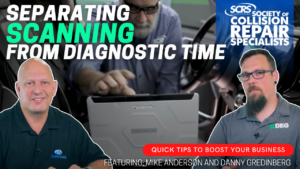
Bumper Prompt, Spark Paper, Scheduling and Scans: 4 Tips from SCRS, DEG and Mike Anderson
By onAssociations | Business Practices | Education | Repair Operations
Since January 2021, the Society of Collision Repair Specialists has released weekly videos featuring Mike Anderson, CEO of CollisionAdvice.com, and Danny Gredinberg, Administrator for the Database Enhancement Gateway (DEG) touching on quick tips for collision repair centers.
Here’s a roundup of recent tips posted on the association YouTube channel over the last several weeks. Members of the industry can subscribe to the SCRSCollision YouTube webpage to be notified as new tips are released.
Answering the CCC Bumper Prompt
In this Aug. 12 video, Anderson and Gredinberg tackle one of the most problematic questions in the collision repair industry – “Will the bumper be refinished in a separate procedure from the other panels?”
How you answer the prompt can affect the bottom line of the repair plan, result in overlap deductions, and determine if those panels will be included in a clear coat cap.
Danny and Mike talk through the material considerations that will inform your answer of “yes” or “no,” distinguishing that if the bumper cover requires a different clear coat mix because of flex additives, a separate procedure is required.
The Society of Collision Repair Specialists has a resource guide for explaining the proper answer, found online on the SCRS website.
Using Spark Paper to Protect the Vehicle
Collision repair professionals have an obligation to protect customer vehicles from incurring additional damage as a result of the repair process, and this Aug. 19 Quick Tip highlights the use of spark paper to protect the vehicle and its components from damage that could occur as a result of welding or grinding.
“Much cheaper to protect the vehicle interior or the exterior trim of the vehicle than to replace those components over…self-inflicted damage,” advised Gredinberg.
The DEG Administrator also noted the resolution from DEG Inquiry 13434, with a proposed resolution from MOTOR stating, “it has been determined that covering the exterior, interior and components of the vehicle to prevent weld spark damage is not included with welded panel replacement estimated work times.” MOTOR continued that “Determining an estimating work time for these procedures would require an ‘on the spot evaluation’ when developing the estimate.”
Scheduling
The first tip of September focused on scheduling incoming work throughout the week, Monday – Friday, to achieve optimal work in process (WIP).
In this nearly 6 minute video – one of the longer releases in the Quick Tip series – Mike and Danny discuss effective solutions to stagger drop offs and successful mechanisms to achieve a more consistent schedule.
From online scheduling that allows consumers to make appointments based on availability, to backfilling and incentivizing end-of-week drop-offs earlier in your week, the duo tackle a variety of ways to find scheduling improvement.
“What I like to do is schedule by hours,” according to Anderson. “I like to figure out what I call my Optimal WIP.”
Anderson works through the math of the total number of technicians and expected labor output, multiplied by the repair facility’s cycle time goal to determine the “optimal WIP.”
Anderson also advised shops that scheduling appropriately might help improve work conditions and lessen stress for technical staff in the repair facility.
Separating Scan Time from Diagnostic Time
The most recent posted video from Sept 9, Mike and Danny talk about the importance of separately itemizing the labor for performing scans from other diagnostic work.
In a March 2021 document from the Alliance of Automotive Service Providers, Automotive Service Association and Society of Collision Repair Specialists, scanning is defined simply as “a mechanical operation to connect a qualified diagnostic scan tool into an OBD-II port or other communication ports in order to retrieve all Diagnostic Trouble Codes (DTC)s using the most current, available OEM information to ensure a proper and safe repair.”
Everything else is separate, according to the trade groups, and that point is reinforced by Anderson in the Quick Tip.
Quite simply, Anderson asks, “are you separating out your scanning time, pre-scan time, from your diagnostic time?”
New tips are released to the SCRSCollision channel every week on Thursday. The next video to be published on Thursday, Sept. 16 will cover performing water leak tests as a part of the quality control process.
More information:
“SCRS Quick Tips: Scheduling for Optimal Work In Process – (Optimal WIP) – Schedule Monday – Friday”
SCRSCollision YouTube Channel, Sep. 2, 2021
“SCRS Quick Tips: Using Spark Paper to Protect the Vehicle”
SCRSCollision YouTube Channel, Aug. 19, 2021
“SCRS Quick Tips: Answering the CCC Bumper Prompt Correctly”
SCRSCollision YouTube Channel, Aug. 12, 2021
AASP, ASA, SCRS define scanning, ‘qualified’ tool, personnel
